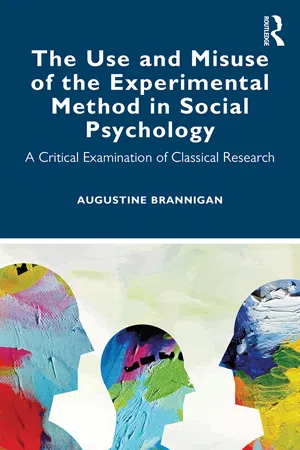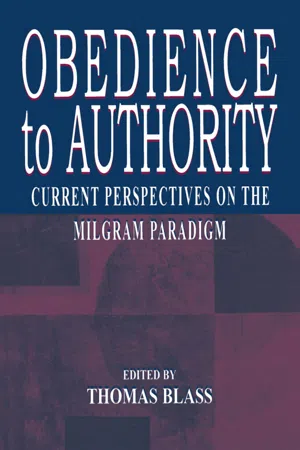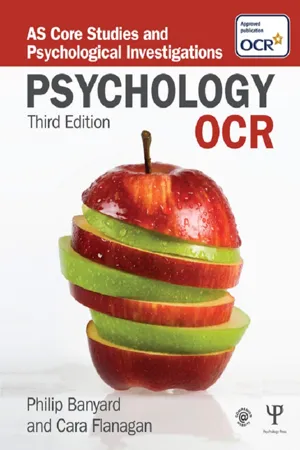Psychology
Milgram's Variation Studies
Milgram's Variation Studies were a series of experiments conducted by psychologist Stanley Milgram to investigate the factors influencing obedience to authority. These studies involved altering certain variables, such as the proximity of the authority figure or the presence of disobedient peers, to understand their impact on obedience levels. The findings revealed the powerful influence of situational factors on human behavior.
Written by Perlego with AI-assistance
Related key terms
7 Key excerpts on "Milgram's Variation Studies"
- eBook - ePub
Great Ideas in Psychology
A Cultural and Historical Introduction
- Fathali Moghaddam(Author)
- 2013(Publication Date)
- Oneworld Publications(Publisher)
2 Imagine living in the seventeenth century rather than the twenty-first century. What are some ways in which you would experience less individual rights and be expected to show greater obedience to authority?THE EXPERIMENTAL STUDY OF OBEDIENCE
Before 1960, two ground-breaking series of studies on conformity were conducted by psychologists, the first initiated by Muzafer Sherif in the 1930s and the second by Solomon Asch in the 1950s. Both of these series of studies were conducted in contexts involving issues that had little real-world significance: estimating the movement of a spot of light (in the case of Sherif’s studies) and estimating lengths of lines (in the case of Asch’s studies). During 1959–60 Stanley Milgram was working in Asch’s laboratory and thinking about what would happen if instead of the movement of a spot of light, judgments of line lengths, or the like, issues of greater human significance were introduced into the laboratory. Would the individual still bend to the will of the majority? This question was the point of departure for Milgram’s studies on obedience to authority, and it eventually led to the question of how far individuals would obey an authority figure.Milgram recruited participants by advertising for volunteers aged 20–50 to take part in a study on the effect of punishment on learning. Participants were told that a goal of the research was to discover how much punishment is good for learning, how much difference it makes whether an older or younger person is giving the punishment, and similar such questions. From the pool of applicants he was able to select a sample of participants with varied ages and backgrounds. In each experiment, the participants were forty percent skilled and unskilled workers, forty percent white-collar, sales, and business, and twenty percent professionals. All those selected had been screened to ensure that they had a normal psychological profile. When the selected participants arrived at Milgram’s laboratory, they were introduced to another person who was supposedly also a participant but was actually a middle-aged accountant selected to act as Milgram’s confederate. It was explained to the participants that this learning experiment required a teacher and a student. The two participants drew lots to decide who would play the role of the teacher and who would play the role of the student, but the outcome was pre-arranged so that the confederate would always play the role of student. There was also a scientist in a white laboratory coat in the room, purportedly in charge of the “learning study.” - eBook - ePub
The Use and Misuse of the Experimental Method in Social Psychology
A Critical Examination of Classical Research
- Augustine Brannigan(Author)
- 2020(Publication Date)
- Routledge(Publisher)
de novo without influence from the earlier research. Milgram approached many groups to determine what they thought would be the normal responses to his experimental manipulations, and, especially, what people would estimate the refusal rates would look like. Psychiatrists, college students, and middle-class adults predicted that 100% of the subjects would defy the authority figure and refuse to administer the lethal levels of shock.In the Blackwell Reader in Social Psychology , Hewstone, Manstead, and Stroebe summarized the study: “There is no experimental design as such; no factors are manipulated. No statistics are reported on the data nor are they needed since no experimental variations were compared” (1997:54). This characterization is not entirely fair. Milgram studied a number of different conditions of aggression, the most famous of which was proximity. He argued that the closer the victim to the context of aggression, the lower the levels of compliance. He also tested the effects of group mediation of compliance. Indeed, he reports twenty-three different conditions of obedience, suggesting again that the research was inherently inductive. Milgram found that the majority of subjects in the baseline experiments did administer the maximum level of shock but that this declined the more proximal the victim was to the teacher. He concluded that compliance of individuals in bureaucratic condition results from the force of authority figures on their obedience. His experiment extracted this general human tendency from the reports of the Holocaust killers who reported that their role in genocide was a result of “just following orders.” This has been the dominant view of the obedience studies over the last six decades.Criticisms were raised both in terms of internal and external validity. As for internal validity, contrary to the received view, Orne and Holland (1968), Mixon (1971), and other critics argued that, in psychology experiments, subjects presume that “nothing can go wrong” and that bad things may not be as bad as they seem. Even though subjects are told that the shocking device delivered some 450 volts and are demonstrated through a sample that the volts are, well, electrifying, most presuppose that “this must be OK – no one can really get hurt.” Universities cannot permit that to happen. - eBook - ePub
Psychoanalysis, Classic Social Psychology and Moral Living
Let the Conversation Begin
- Paul Marcus(Author)
- 2019(Publication Date)
- Routledge(Publisher)
banality of evil comes closer to the truth than one might dare imagine. The ordinary person who shocked the victim did so out of a sense of obligation—a conception of his duties as a subject—and not from any particular aggressive tendencies. This is, perhaps, the most fundamental lesson of our study: ordinary people, simply doing their jobs, and without any particular hostility on their part, can become agents in a terrible destructive process.(Milgram, 1974, pp. 5–6)It is mainly within the psychosocial context of trying to fathom the Holocaust that Milgram designed a series of obedience to authority experiments that provided “evidence of probably the most compelling phenomenon ever uncovered by social psychology” (Reicher & Haslam, 2017, p. 125). Indeed, researchers and scholars are still debating Milgram’s fifty-year-old findings and analyses, though the obedience to authority phenomenon “still lacks a compelling explanation” (ibid.).The obedience shock experiments
In Experiment 5, the most famous of the eighteen variations, Milgram informed naïve subjects in the all-males study that they were engaged in a scientific investigation of the effects of punishment on learning [all were “decent and courteous” in real-life says Milgram (1974, p. 132)]. One of the men in each participant pair would act as the “Learner” and would attempt to do a simple task involving memory by supplying a word. The other man was the “Teacher” who was requested to read the words to the Learner and would punish mistakes through an electric shock if the Learner did not provide the second word in each pair. The shocks were delivered by an imposing, realistic-looking machine (henceforth, the shock generator) that contained thirty numbered switches spanning from 15 volts (“slight shock”) through 450 volts (“XXX”; the descriptor for 375 volts read, “danger severe shock”), reflecting the first to the thirtieth switch. The two participants involved in the study, the naïve subject (the Teacher) and a research assistant (the Learner) then drew slips of paper from a hat to decide who would assume each role. The drawing was rigged so that the naïve subject always assumed the role of the Teacher. The Teacher was then instructed by the scientific-looking authority in a white coat to give a shock to the Learner whenever he made an error on the memory task. Most importantly, the Teacher was instructed that they had to increase the strength of the shock each time the Learner made a mistake. What this meant was that when the Learner made numerous mistakes, he would soon be getting strong and seemingly painful jolts of electricity. It is vital to understand that the Learner, who was actually a research assistant, never received any shocks during the experiment. The only time a shock was ever used was a mild pulse from switch number three to persuade naïve subjects that the shock generator was in fact real. - eBook - ePub
Inaccuracies in Children's Testimony
Memory, Suggestibility, or Obedience to Authority?
- Letitia C Pallone, Jon'A F Meyer(Authors)
- 2013(Publication Date)
- Routledge(Publisher)
1 Seventeen variations of his original experiment produced similar results. In general, the subjects did what the authority told them to, whether or not it could be viewed as seriously harming another.Milgram invited normal adult men2 living in the communities surrounding Yale University to participate in what he told them was a study of the effects of negative reinforcement on learning behavior (for a brief description of Milgram's eighteen experiments, see Table 5.1 ). The subjects entered the laboratory3 in pairs4 and were told the following:. . . we know very little about the effect of punishment on learning, because almost no truly scientific studies have been made of it in human beings.For instance, we don't know how much punishment is best for learning—and we don't know how much difference it makes as to who is giving the punishment, whether an adult learns best from a younger or an older person than himself—or many things of that sort.So in this study we are bringing together a number of adults of different occupations and ages. And we're asking some of them to be teachers and some of them to be learners.We want to find out just what effect different people have on each other as teachers and learners, and also what effect punishment will have on learning in this situation.Therefore, I'm going to ask one of you to be the teacher here tonight and the other one to be the learner. Does either of you have a preference?(Milgram 1963 , p. 373)The two subjects then participated in a draw to determine who would be the learner (a person whose task was to listen and select which of a list of four words had originally been paired with a target word), and who would be the teacher (a person who would punish the learner for each mistake). The draw, of course, was rigged: thesubject was always assigned the role of teacher, while the confederate5 - eBook - ePub
Obedience to Authority
Current Perspectives on the Milgram Paradigm
- Thomas Blass(Author)
- 1999(Publication Date)
- Psychology Press(Publisher)
There is no question of Stanley Milgram’s pre-eminence as a behavioral researcher (Blass, 1992, 1996), the architect of “the most well-known research in social psychology, perhaps all of psychology” (Brock & Brannon, 1994, p. 259). An introductory psychology textbook would be incomplete without mention of Milgram’s obedience experiments (Perlman, 1980). A social psychology course without them would be unthinkable (Perlman, 1979). Some prominent social psychologists have been unreserved in recognizing a unique quality in Milgram’s obedience research, that applies to no other study within the field. For example, Muzafer Sherif (1975) said, “Milgram’s obedience experiment is the single greatest contribution to human knowledge ever made by the field of social psychology, perhaps psychology in general.” And at Milgram’s eulogy in December, 1984, his close colleague Irwin Katz noted “When viewed in relation to the main body of psychology…, Stanley Milgram’s work on obedience stands by itself—an indestructible monolith on an uninhabited plain.” Besides the obedience studies, which he conducted in his twenties, he went on to do other pioneering research on city life, the media, cognitive maps, and a score of diverse topics (Blass, 1992), that made him one of the few social scientists to directly impact our popular culture—including Broadway theater and feature films (Takooshian, 1998), and a television play based on the obedience experiments (Milgram, 1976).Yet the fact is that Milgram was also a teacher throughout his career—first at Yale (1960–1963), then at Harvard (1963–1967), and finally at the City University of New York (1967–1984). In fact, his teaching at CUNY began at age 33, as a full professor and head of the social psychology doctoral program, and ended by chairing a student’s defense of her dissertation at 2 pm on December 20, 1984, a few hours before he succumbed to heart failure. His 24 continuous years of teaching were punctuated only by a few sabbaticals and, starting in 1980, some brief medical leaves interspersed among his 4 heart attacks. His teaching materials fill some 106 boxes in the Yale University archives. Soon after his untimely death, the American Psychological Foundation (APF) considered Milgram’s nomination by his students for its annual award for Distinguished Teaching in Psychology, but APF policy ultimately excluded a posthumous Award. (See Appendix - eBook - ePub
OCR Psychology
AS Core Studies and Psychological Investigations
- Philip Banyard, Cara Flanagan(Authors)
- 2013(Publication Date)
- Psychology Press(Publisher)
- It is a novel situation for the participant who therefore doesn’t know how to behave. If it was possible to discuss the situation with others the participant might have behaved differently.
- The participant assumes that the discomfort caused is minimal and temporary, and that the scientific gains are important.
- Since the learner has ‘played the game’ up to shock level 20 (300 volts) the participant assumes the learner is willing to continue with the experiment.
- The participant is torn between meeting the demands of the victim and those of the experimenter.
- The two demands are not equally pressing and legitimate.
- The participant has very little time to resolve this conflict and he doesn’t know that the victim will remain silent for the rest of the experiment.
- The conflict is between two deeply ingrained tendencies: not to harm someone and to obey those whom we perceive to be legitimate authorities.
5.5 Qs
- Milgram listed 13 explanations for the high levels of obedience that he observed. Select three of these explanations – the ones you feel are the ‘best’.
- There have been many ethical criticisms of this study. On balance do you think that Milgram was justified in conducting this study?
…Links to core studies…Milgram’s conclusion is that we are made by the situations we are in. The issue of situations and opportunity is also dealt with in the studies by Griffiths and also Piliavin et al. Both these studies share another characteristic with Milgram in that they attempted to explore human behaviour in real-life settings.Further details of the study were provided by Milgram in his book Obedience to Authority (1974 ). These may be useful when considering your evaluations.- The participants were sent a follow-up questionnaire, which showed that 84% felt glad to have participated, and 74% felt they had learned something of personal importance.
- Milgram did think about abandoning the study when it became clear that some participants were quite stressed. However, he decided that ‘momentary excitement is not the same as harm’ (1974, page 212).
- eBook - ePub
- Kenneth S. Bordens, Irwin A. Horowitz(Authors)
- 2013(Publication Date)
- Psychology Press(Publisher)
Milgram’s original experiments were conducted in the United States, using a particular research technique. Would his results hold up across cultures and across experimental situations? Some critics of Milgram’s study, Dutch researchers Meeus and Raaijmakers (1986), argued that the type of obedience required in Milgram’s experiment—physically hurting another person— was not realistic. Such behavior is rare in everyday life. They argued that people are more often asked to hurt others in more subtle ways. For example, your employer might ask you to do something that makes another employee look bad. Would you obey?Meeus and Raaijmakers (1986) studied a different form of obedience: administrative obedience . Dutch participants were told that the psychology department of a university was commissioned to screen applicants for various state and civic positions and that the department was using this opportunity to test the effects of stress on test achievement. According to instructions, participants made a series of disparaging statements about a person taking a test for a state job. Fifteen statements, each more disruptive than the previous, were used. The mildest statement was, “Your answer to question 9 was wrong”; a moderate statement was, “If you continue like this, you will fail the test”; and the strongest statement was, “According to the test, it would be better for you to apply for lower functions” (p. 323). Understandably, job applicants became increasingly upset with each comment.Most of the Dutch participants obeyed; 90% read all 15 statements. This resembles the Milgram experiment in which participants had to increase shock in 15 stages as the victim became more upset. In Milgram’s terms, they gave the full 450 volts. When questioned about it, they attributed responsibility for the harassment to the experimenter.In another variation on Milgram’s experiment, Australian participants assumed the role of either transmitter of the experimenter’s instructions or executor (Kilham & Mann, 1974). In the transmitter condition, participants relayed orders to continue shocking a learner to a confederate of the experimenter who delivered the shocks. In the executor condition, participants received orders indirectly from the experimenter through a confederate of the experimenter. The hypothesis was that there would be greater obedience when the participant was the transmitter rather than the executor of orders, presumably because the participant is not directly responsible for inflicting harm on the victim. Results supported this hypothesis. Participants in the transmitter role showed higher levels of obedience than those in the executor role.
Learn about this page
Index pages curate the most relevant extracts from our library of academic textbooks. They’ve been created using an in-house natural language model (NLM), each adding context and meaning to key research topics.






